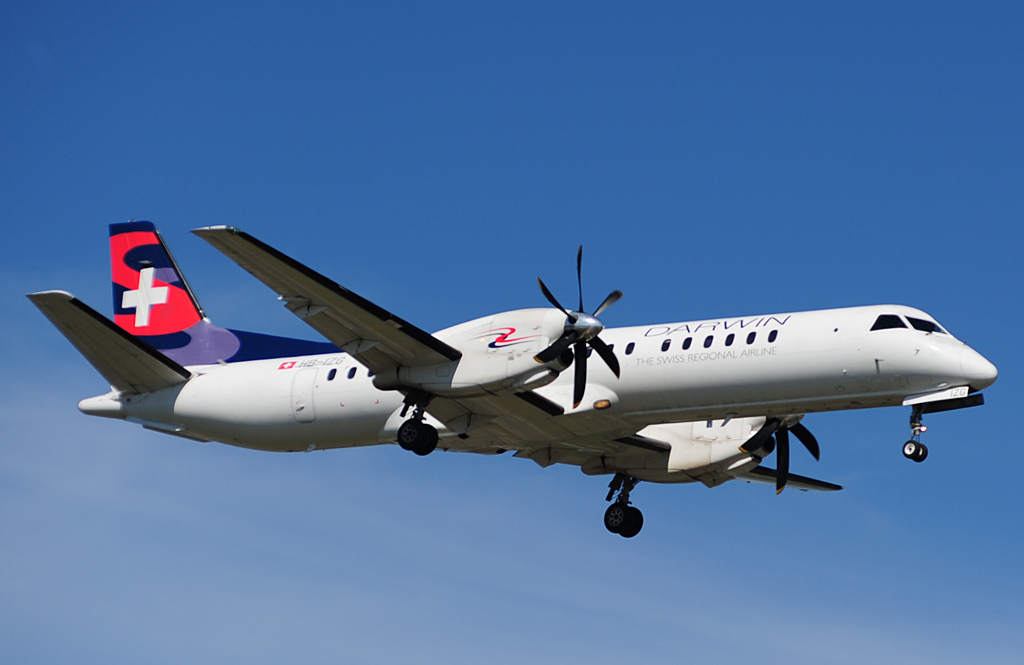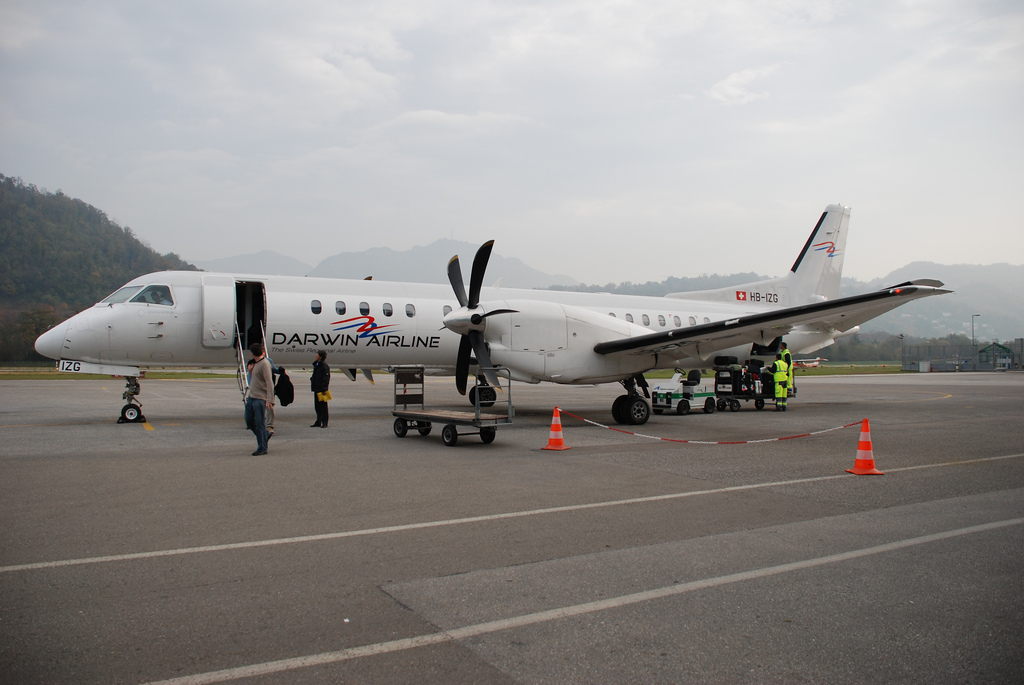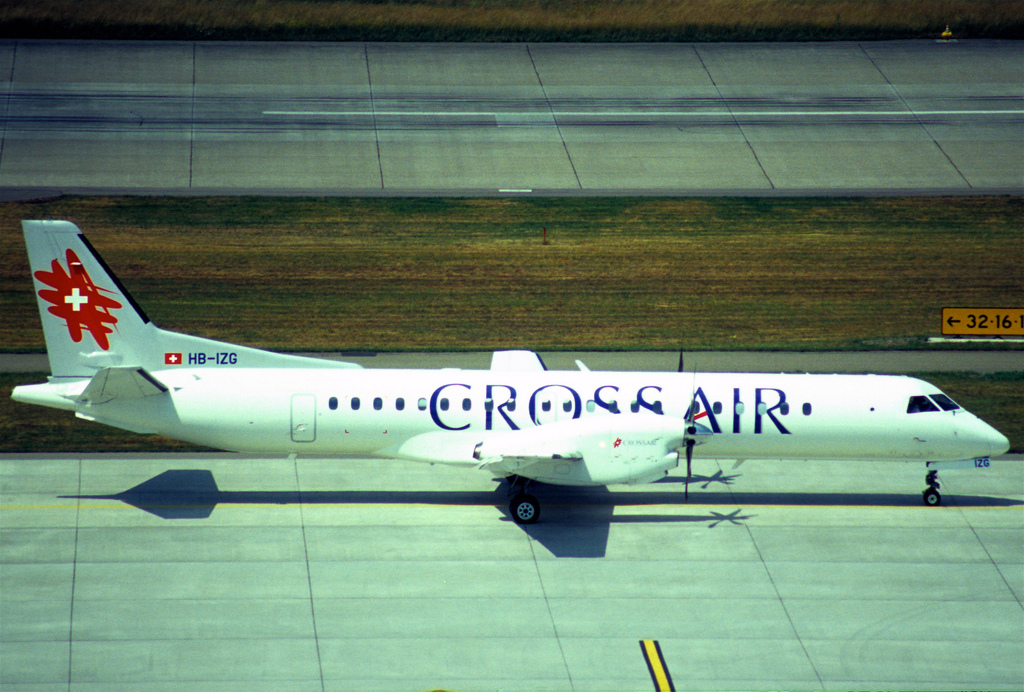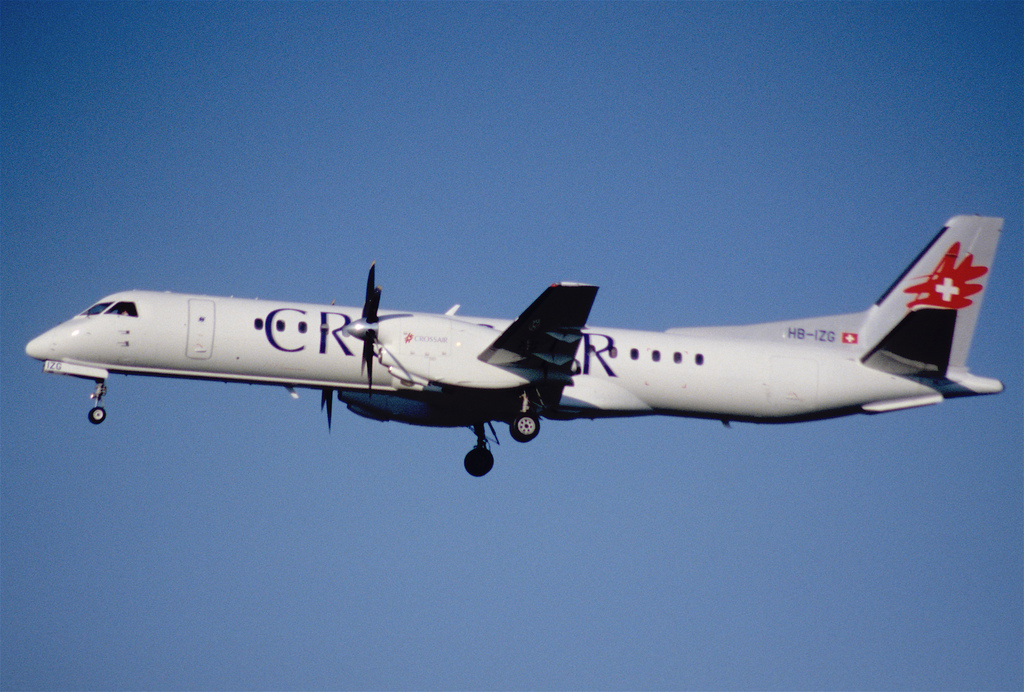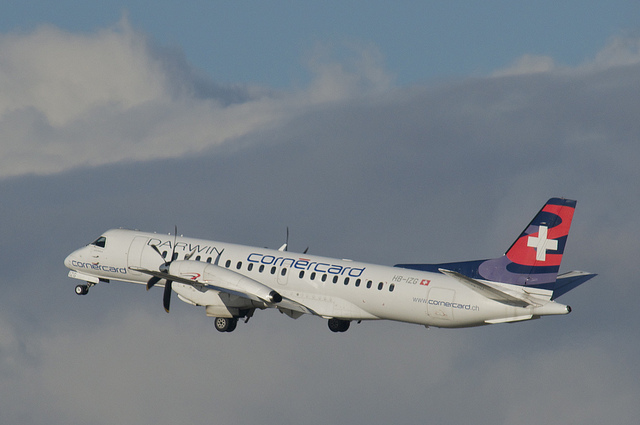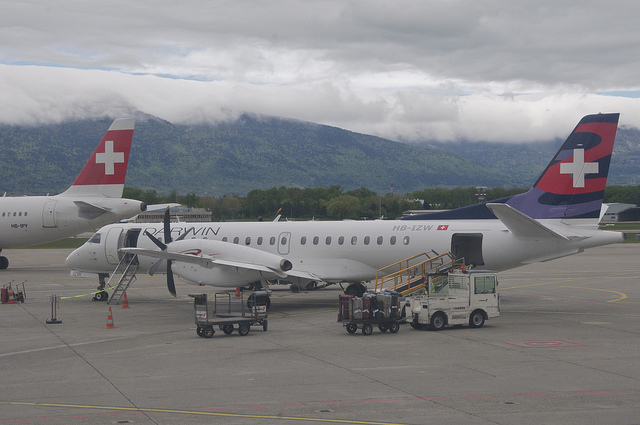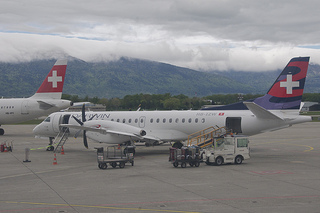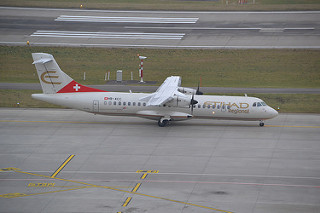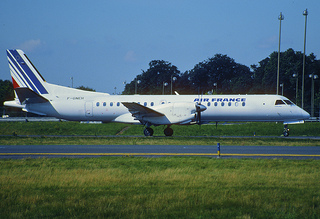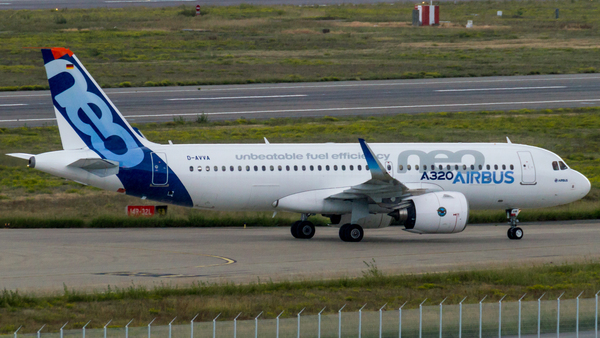Darwin SB20 at Paris on Jan 28th 2014, nose wheels separated on landing
Last Update: May 3, 2017 / 14:38:58 GMT/Zulu time
Incident Facts
Date of incident
Jan 28, 2014
Classification
Accident
Airline
Darwin Airlines
Flight number
F7-250
Departure
Leipzig, Germany
Destination
Paris Charles de Gaulle, France
Aircraft Registration
HB-IZG
Aircraft Type
SAAB 2000
ICAO Type Designator
SB20
Airport ICAO Code
LFPG
The flight was the inaugural flight for Etihad Regional.
The airline reported both nose wheels separated from the nose gear. All occupants of the aircraft left the aircraft safely and were bussed to the terminal.
On Feb 4th 2014 the French BEA reported in their weekly bulletin that the aircraft touched down hard, bounced and touched down a second time causing the the nose gear axle to fracture.
On May 3rd 2017 the BEA released their final report (English version promised soon) concluding the probable causes of the accident were:
During the flare the captain detected the landing would be hard and in an emergency action quickly pulled the nose up without announcing his intention to the first officer, pilot flying.
This lack of coordination created double controls resulting in successive counteracting pilot actions pulling and pushing the controls during following bounce recovery.
The BEA reported that the first officer (CPL, 630 hours total, 80 hours on type) was pilot flying, the captain (ATPL, 6,640 hours total, 2,260 hours on type) was pilot monitoring, the captain had done 50 landings at Charles de Gaulle Airport prior to the accident flight, the first officer was doing his first landing at Charles de Gaulle, the airline considered the first officer as "inexperienced".
The first officer briefed the approach, the aircraft was vectored onto the ILS for runway 27R. Descending through 2300 feet AGL the aircraft was fully configured for landing (flaps 20 degrees, gear down), descending through 1000 feet AGL the aircraft was fully stable. At 400 feet AGL the first officer disconnected the autopilot, at decision height of 200 feet AGL the crew decided to continue the approach.
At 50 feet AGL the first officer began to gradually reduce engine power, pulled the nose up increasing the pitch from 0 to 3 degrees nose up, continuing to pull the yoke further back until it reached the full stop (pitch 5 degrees nose up). The main wheels hit the ground hard at 120 KIAS, the flaps automatically retract from 20 to 15 degrees. The aircraft bounced twice with the yoke alternating between pushes and pulls.
The BEA reported that analysis of the flight data recorder does not permit to determine who did what. However, the interviews with the flight crew suggest, that the commander applied a sudden and substantial nose up input during round out which the first officer was surprised with and counteracted. The aircraft bounced with the captain still applying nose up input and first officer counteracting with a nose down input, while in the bounce the first officer stopped his input which resulted in the yoke hitting the aft full stop due to the captain's nose up input no longer being counteracted. The aircraft bounced again, the commander added engine power which was immediately counteracted by the first officer, the nose gear hit the runway at a high rate of descent, the nose wheel axle fractured. The aircraft came to a stop on the runway and was disabled.
The first officer radioed tower "emergency on the ground", the controller requested them to vacate the runway, the first officer reported that they were unable to vacate the runway, the controller repeated his request to vacate the runway, only then the first officer declared Mayday. The controller now pushed the emergency button alerting emergency services, about one minute after the first radio transmission "emergency on the ground".
The BEA analysed that the nose gear axle fractured due to overload in severe impact with the runway at a rate of 11.5 feet/second (690fpm). During the first two ground contacts only both main gear were in touch with the runway, during the third touchdown only the nose gear was in contact with the runway.
The BEA analysed that the company did not establish a procedure for bounce recovery. The aircraft manufacturer recommended to maintain a normal landing attitude and add power as needed, a shallow bounce should not need power. On hard bounces initiate a go around, a second touch down might occur during go around.
Metars:
LFPG 280800Z 19013KT 9999 -RA BKN010 04/02 Q0994 NOSIG
LFPG 280730Z 19014KT 9999 BKN010 04/02 Q0994 NOSIG
LFPG 280700Z 18015KT 9999 BKN010 04/02 Q0994 NOSIG
LFPG 280630Z 20014KT 9999 BKN010 04/02 Q0994 NOSIG
LFPG 280600Z 20015KT 9999 BKN010 04/02 Q0995 NOSIG
LFPG 280530Z 19014KT 9999 BKN010 03/01 Q0995 NOSIG
LFPG 280500Z 19014KT 9999 BKN009 03/01 Q0995 NOSIG
LFPG 280430Z 19013KT 9999 BKN009 03/01 Q0995 NOSIG
LFPG 280400Z 19015KT 9999 BKN009 03/01 Q0995 NOSIG
LFPG 280330Z 19013KT 9999 BKN010 BKN050 03/01 Q0996 NOSIG
LFPG 280300Z 19013KT 9999 SCT009 SCT042 03/01 Q0996 NOSIG
Aircraft Registration Data
Incident Facts
Date of incident
Jan 28, 2014
Classification
Accident
Airline
Darwin Airlines
Flight number
F7-250
Departure
Leipzig, Germany
Destination
Paris Charles de Gaulle, France
Aircraft Registration
HB-IZG
Aircraft Type
SAAB 2000
ICAO Type Designator
SB20
Airport ICAO Code
LFPG
This article is published under license from Avherald.com. © of text by Avherald.com.
Article source
You can read 2 more free articles without a subscription.
Subscribe now and continue reading without any limits!
Read unlimited articles and receive our daily update briefing. Gain better insights into what is happening in commercial aviation safety.
Send tip
Support AeroInside by sending a small tip amount.
Related articles
Darwin SB20 at Zurich on Aug 22nd 2012, close encounter with touch and go on crossing runway
On Sep 24th 2014 Switzerland's SUST (former BFU) released their final report reporting the minimum separation between the aircraft reduced to 205m…
Darwin SB20 at Billund on Dec 10th 2015, descended below minimum safe height
A Darwin Airlines Saab 2000 on behalf of Air Berlin, registration HB-IZW performing flight AB-8054 from Berlin Tegel (Germany) to Billund (Denmark)…
Darwin SB20 at Lugano on Nov 28th 2013, engine shut down in flight
A Darwin Airlines Saab 2000 on behalf of Swiss, registration HB-IZW performing flight LX-2903 from Lugano to Zurich (Switzerland) with 25 passengers…
Darwin SB20 at Lugano on Jun 1st 2016, unsafe nose gear
A Darwin Airlines Saab 2000, registration HB-IZJ performing flight F7-17 from Geneva to Lugano (Switzerland), was on approach to Lugano when the crew…
Darwin AT72 at Naples on May 18th 2016, dropped nose wheel on takeoff
A Darwin Airlines Avions de Transport Regional ATR-72-212A on behalf of Alitalia, registration HB-ACC performing flight AZ-1203 from Naples to…
Darwin SB20 near Dresden on Mar 3rd 2015, engine shut down in flight
A Darwin Airlines Saab 2000 on behalf of Etihad Regional, registration HB-IYI performing flight F7-263 from Dresden (Germany) to Zurich (Switzerland)…
Newest articles
ASL UK AT72 at East Midlands on Nov 14th 2025, tyre and runway damage on landing
An ASL Airlines UK Avions de Transport Regional ATR-72-212A freighter, registration G-OASB performing flight ABV-108 from Guernsey,CI to East…
TAP A20N at Lisbon on Nov 14th 2025, lightning strike
A TAP Air Portugal Airbus A320-200N, registration CS-TVP performing flight TP-862 from Lisbon (Portugal) to Venice (Italy), was climbing out of…
Subscribe today
Are you researching aviation incidents? Get access to AeroInside Insights, unlimited read access and receive the daily newsletter.
Pick your plan and subscribePartner

ELITE Simulation Solutions is a leading global provider of Flight Simulation Training Devices, IFR training software as well as flight controls and related services. Find out more.
SafetyScan Pro provides streamlined access to thousands of aviation accident reports. Tailored for your safety management efforts. Book your demo today
AeroInside Blog
Popular aircraft
Airbus A320Boeing 737-800
Boeing 737-800 MAX
Popular airlines
American AirlinesUnited
Delta
Air Canada
Lufthansa
British Airways

